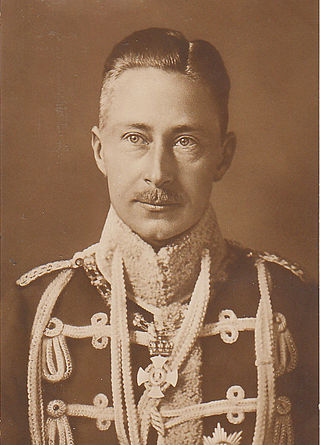
Wilhelm, German Crown Prince, Crown Prince of Prussia was the eldest child of the last Kaiser, Wilhelm II, German Emperor, and his consort Augusta Victoria of Schleswig-Holstein, and thus a great-grandson of Queen Victoria, and distant cousin to many British royals, such as Queen Elizabeth II. As Emperor Wilhelm's heir, he was the last Crown Prince of the German Empire and the Kingdom of Prussia, until the abolition of the monarchy.
The Grand Cross of the Iron Cross was a decoration intended for victorious generals of the Prussian Army and its allies. It was the second highest class of the Iron Cross, following the Star of the Grand Cross of the Iron Cross, which was awarded only twice. Along with the Iron Cross 1st and 2nd Class, the Grand Cross was founded on 10 March 1813, during the Napoleonic Wars. It was renewed in 1870 for the Franco-Prussian War and again in 1914 for World War I. In 1939, when Adolf Hitler renewed the Iron Cross as a German decoration, he also renewed the Grand Cross.

Karl Wilhelm Paul von Bülow was a German field marshal commanding the German 2nd Army during World War I from 1914 to 1915.

The Order of the Black Eagle was the highest order of chivalry in the Kingdom of Prussia. The order was founded on 17 January 1701 by Elector Friedrich III of Brandenburg. In his Dutch exile after World War I, deposed Emperor Wilhelm II continued to award the order to his family. He made his second wife, Princess Hermine Reuss of Greiz, a Lady in the Order of the Black Eagle.

The Royal Order of the Crown was a Prussian order of chivalry. Instituted in 1861 as an honour equal in rank to the Order of the Red Eagle, membership could only be conferred upon commissioned officers, but there was a medal associated with the order which could be earned by non-commissioned officers and enlisted men.

Prince Wilhelm Eitel Friedrich Christian Karl of Prussia was the second son of Emperor Wilhelm II of Germany by his first wife, Princess Augusta Viktoria of Schleswig-Holstein-Sonderburg-Augustenburg. He was born and died in Potsdam, Germany.
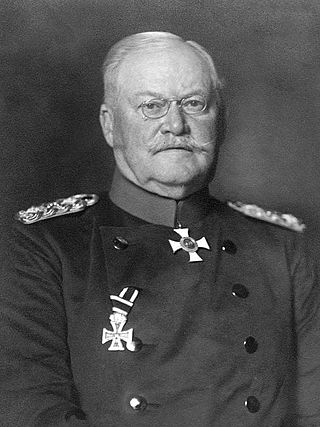
Maximilian “Max” Wilhelm Gustav Moritz von Prittwitz und Gaffron was an Imperial German general. He fought in the Austro-Prussian War, the Franco-Prussian War, and briefly in the First World War.

Prince Frederick Charles Alexander of Prussia was a younger son of Frederick William III of Prussia. He served as a Prussian general for much of his adult life and became the first Herrenmeister of the Order of Saint John after its restoration as a chivalric order. Nevertheless, he is perhaps remembered more often for his patronage of art and for his sizable collections of art and armor.
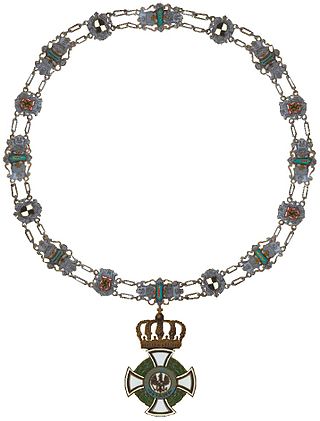
The House Order of Hohenzollern was a dynastic order of knighthood of the House of Hohenzollern awarded to military commissioned officers and civilians of comparable status. Associated with the various versions of the order were crosses and medals which could be awarded to lower-ranking soldiers and civilians.
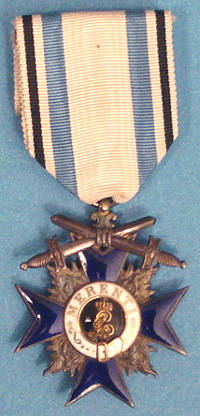
The Bavarian Military Merit Order was established on 19 July 1866 by King Ludwig II of Bavaria. It was the kingdom's main decoration for bravery and military merit for officers and higher-ranking officials. Civilians acting in support of the army were also made eligible for the decoration. The Military Merit Order ranked below the Military Order of Max Joseph (Militär-Max-Joseph-Orden), which was Bavaria's highest military honor for officers.

The House and Merit Order of Duke Peter Frederick Louis or proper German Oldenburg House and Merit Order of Duke Peter Frederick Louis was a civil and military order of the Grand Duchy of Oldenburg, a member state of the German Empire. The order was founded by Grand Duke Augustus of Oldenburg on 27 November 1838, to honor his father, Peter Frederick Louis of Oldenburg. It became obsolete in 1918 after the abdication of the last grand duke.

Wilhelm Gustav Karl Bernhard von Hahnke was a Prussian Field Marshal, and Chief of the German Imperial Military Cabinet from 1888 to 1901.

Georg Alexander von Müller was an Admiral of the Imperial German Navy and a close friend of the Kaiser in the run up to the First World War.
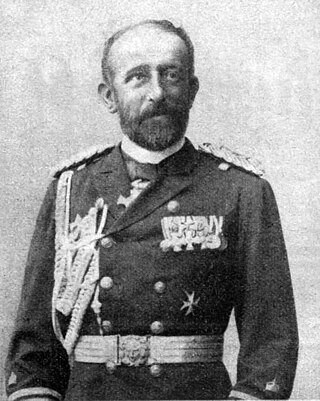
Gustav Ernst Otto Egon Freiherr (Baron) von Senden-Bibran was an admiral of the German Imperial Navy.
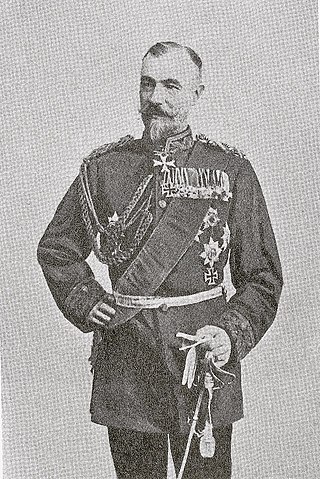
Walther Franz Georg Bronsart von Schellendorff, Dr. jur. h.c., was a Prussian General of the Infantry à la suite, Adjutant-General to the Kaiser and King, and Prussian Minister of War.

August Wilhelm Heye was a German officer who rose to the rank of Generaloberst and became head of the Army Command within the Ministry of the Reichswehr in the Weimar Republic. One of his sons was admiral Hellmuth Heye.

The House Order of Henry the Lion In German: Hausorden Heinrichs des Löwen, was the House Order of the Duchy of Brunswick. It was instituted by William VIII, Duke of Brunswick on 25 April 1834. The ribbon of the Order was red with yellow edges. It had five grades: Grand Cross, Grand Commander with Sash, Commander, Knight 1st Class, Knight 2nd Class, plus Medal of Merit for Science and Arts, the Cross of Merit and the Medal of Honour. The Order was named in honour of Henry the Lion, who remains a popular figure to this day.

Gustav Emil Bernhard Bodo von Kessel was a German general who served in the Austro-Prussian War, the Franco-Prussian War and World War I.

Hugo Moritz Anton Heinrich Freiherr von Obernitz was a Prussian general who served as adjutant general of Kaiser Wilhelm I.

Karl, Prince of Wedel, born Karl Leo Julius Graf von Wedel, was a Prussian general and diplomat who served as the fourth Imperial Lieutenant of the Reichsland of Alsace–Lorraine from 27 October 1907 until his resignation on 18 April 1914.































